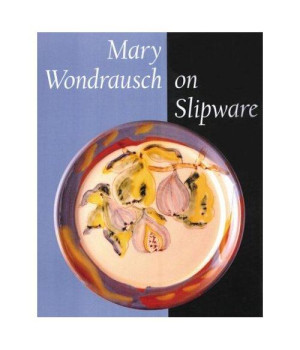Mary Wondrausch On Slipware
SKU: DADAX1574981498
ISBN : 9781574981490
Condition : New
Shipping & Tax will be calculated at Checkout.
US Delivery Time: 3-5 Business Days.
Outside US Delivery Time: 8-12 Business Days.
Mary Wondrausch examines the history of slipware, narrating its development in many countries and discussing the techniques and practicalities involved. As one of the leading practitioners in the field, she writes with great enthusiasm and knowledge about this most joyous and colorful of ceramic styles.
Slipware has a long tradition of being used for commemorative wares and has played an important part in marking historical events both for individuals and nations. This extra role makes this book essential reading both for potters and for ceramic collectors and historians alike. Mary Wondrausch on Slipware is a valuable reference tool as well as a lively read.
What is Slipware?
It sounds like skating or sliding, not like pottery, and many people seem to be unclear about the meaning of this term.
Firstly, it is lead-glazed earthware firing temperature between 1634°F and 2012°F. Secondly, the pots are decorated with colored slip before they are fired in the the kiln. Slip is clay mixed with water. If it is used for covering the body of the pot, it's called pouring slip or engobe. It has a thin, batter-like consistency and is usually of a contrasting color to the body clay; for example, white on a red clay.
Slip trailing is the method of decorating the pot with slip from either a cow-horn, a small clay vessel and quill, or rubber bulb and pipette.
All work that is earthenware and decorated in any way with slips before firing is called slipware. This includes sgrafitto, which is the technique of scratching through a leather-hard covering slip to reveal the contrasting clay body underneath, or in some cases to reveal another slip applied below, as in Beauvais ware.
There is an additional group of wares that come roughly under the sgraffito heading as the possibilities of the method are explored. For example: brushing different colored slips on to the leather-hard background; cutting out the background to reveal large areas of the body color; painting with oxides such as copper and cobalt to enhance the scratched drawing. A combination of all these techniques can be used together on the same pot. Other decorative techniques normally associated with slipware are marbling and feathering.
Slip-decorated earthenware is not be confused with majolica (or Faience or Delft ware), where the painting is done on top of a tin glaze after the first firing. The common feature of majolica and slipware is that they are both earthenware.
From earliest times, painted slips were used as decoration. The most familiar of these pots came from China, Ancient Greece, Byzantium, Egypt, Italy and also from Britain during the period of Roman domination when the Castor wares from Northamptonshire were made and decorated, as they were in Germany at this time.
Lead-glazed, slip-coated wares were imported to Britain from Beauvais and Saintes in France in the 14th century and are found in quantity in many excavated sites. Literally hundreds of chafing dishes (coal pots) from Saintes, known as Saintonge wares, have been excavated all over Britain, undecorated except for splashes of glaze. La Chapelle des Pots near Saintes was known for its strange barrel-type wine containers, heavily embossed and lead-glazed.
Features :
Product dimensions : 10.75x0.75x8.75 inches
Product weight : 2.1 pounds
Write a review
Your Name:
Your Email:
Your Review:
Note: HTML is not translated!
Rating: Bad Good
Enter the code in the box below:



